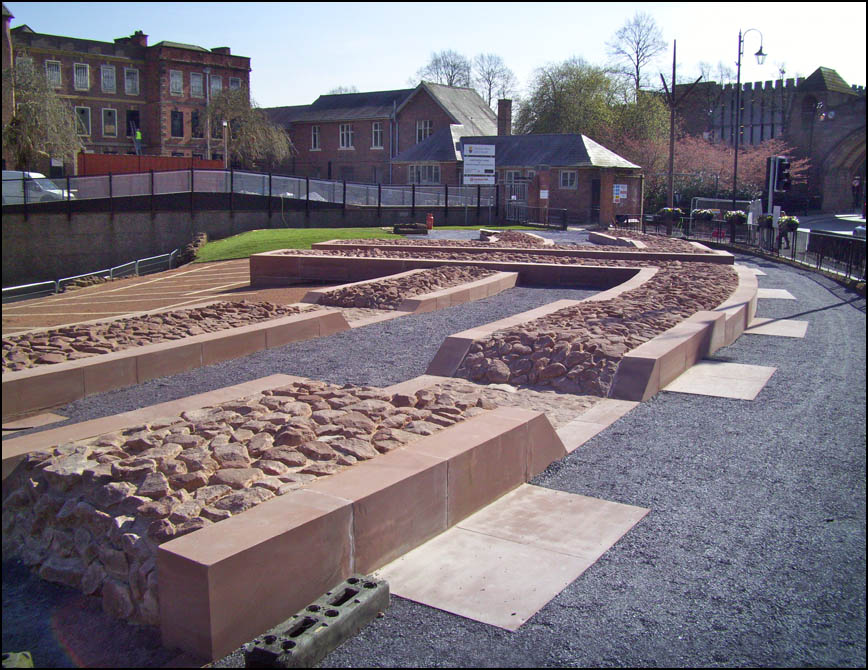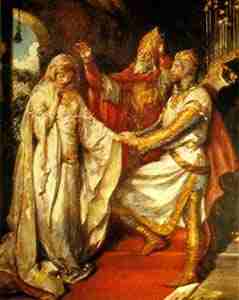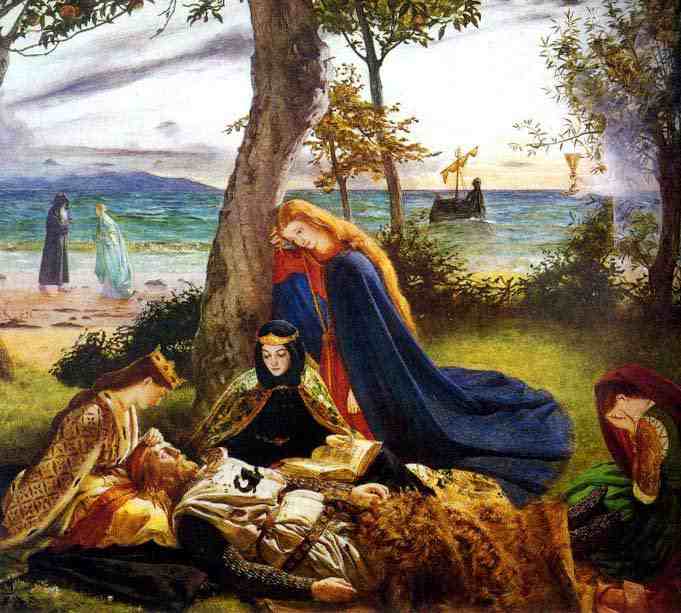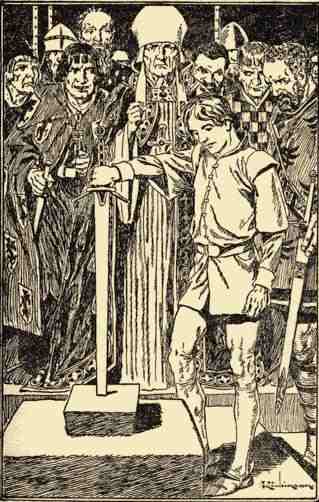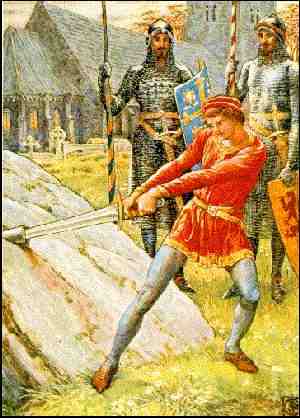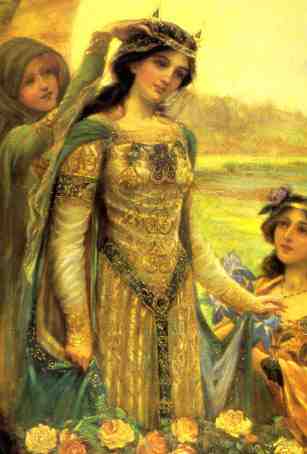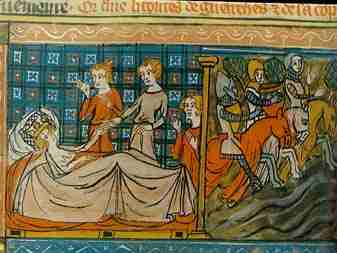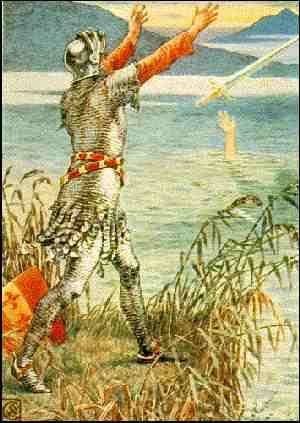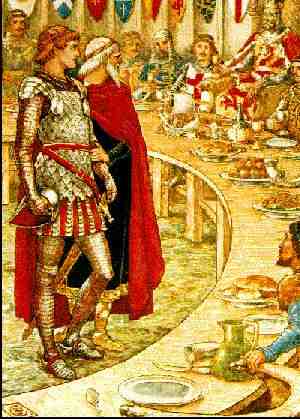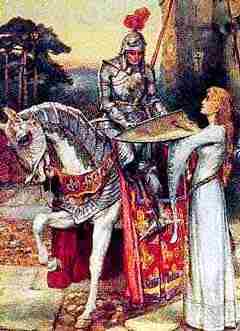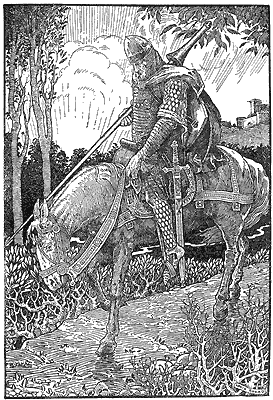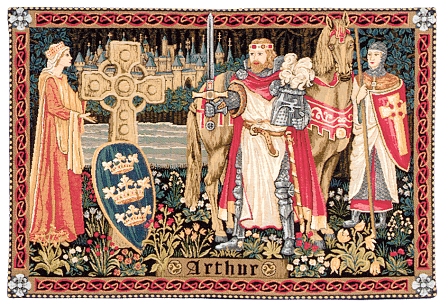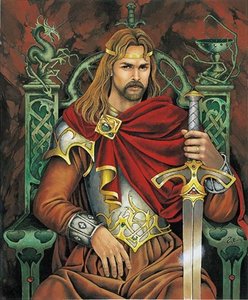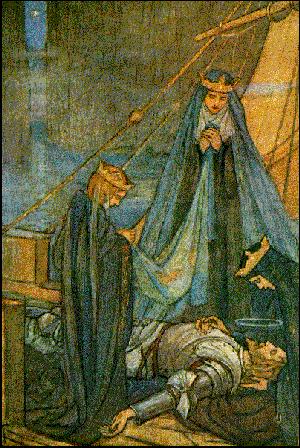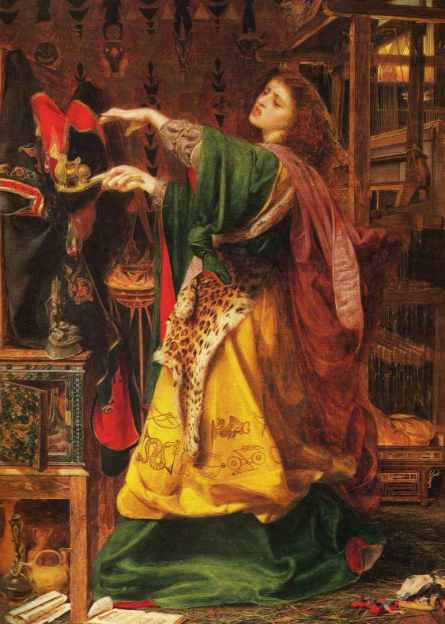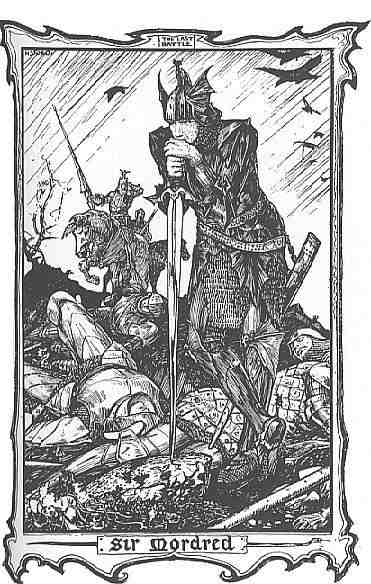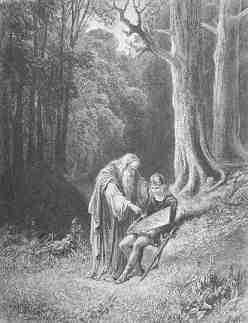AVALON
The Theosophy
King Arthur Pages
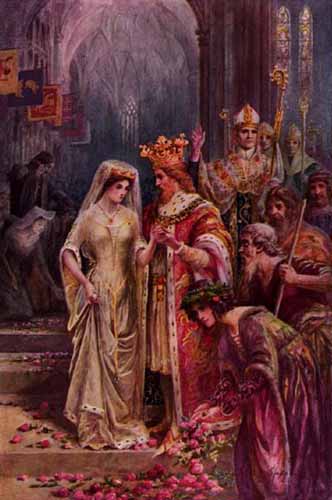
King Arthur’s
Marriage to Guinevere
Chronology
of
in the
5th Century CE
402 Events on the continent force Stilicho to recall
one of the two British legions to assist with the defense of
403 Victricius, Bishop of
over the Pelagian heresy.
405 The British troops, which had been recalled to
assist Stilicho, do not return to Britain as they have to stay in Italy to
fight off another, deeper penetration by the barbarian chieftain,Radagaisus.
406 In early January, 406, a combined barbarian force (Suevi,
Alans, Vandals & Burgundians) sweep into central
immediately assassinated.
407 In place of the assassinated Marcus, Gratian is
elevated "to the purple," but lasts only four months. Constantine III
is hailed as the new
emperor by Roman garrison in Britian. He proceeds to
follow the example of Magnus Maximus by withdrawing the remaining Roman legion,
the Second
408 With both Roman legions withdrawn, Britain endures
devastating attacks by the Picts, Scots and Saxons.
409 Prosper, in his chronicle, says, "in the
fifteenth year of Honorius and Arcadius (409), on account of the languishing
state of the Romans, the strength of the Britons was brought to a desperate
pass."
Under enormous pressure, Britons take matters into
their own hands, expelling weak Roman
officials and fighting for themselves.
410
413 Pelagian heresy said to have begun, by Prosper
(Tiro) of
420 – 30 Pelagian heresy is outlawed in
support Roman church. During this time, according to
421 Honorius issues a decree forbidding any Pelagians
to come nearer to
429 At the request of Palladius, a British deacon, Pope
Celestine I dispatches bishops Germanus of Auxerre and Lupus of
c. 432 Traditional dating for the beginning of St.
Patrick's mission to
c. 438 Birth of Ambrosius Aurelianus, scion of the
leading Romano-British family on the island.
c. 440 – 50 Period of civil war and famine in Britain,
caused by ruling council's weakness and inability to deal with Pictish
invasions; situation
aggravated by tensions between Pelagian/Roman
factions. Vacated towns and cities in ruin. Migration of pro-Roman citizens
toward west. Country beginning to be divided, geographically, along factional
lines.
c. 441 Gallic Chronicle records, prematurely, that
"
c. 445 Vortigern comes to power in
446 Britons (probably the pro-Roman party) appeal to
Aetius, Roman governor of
c. 446 Vortigern authorizes the use of Saxon
mercenaries, known as foederati, for the defense of the northern parts against
barbarian attack.
To guard against further Irish incursions, Cunedda and
his sons are moved from Manau Gododdin in northern
447 Second visit of St. Germanus (this time
accompanied by Severus, Bishop of
c. 447 Britons, aroused to heroic effort,
"inflicted a massacre" on their enemies, the Picts and Irish, and are
left in peace, for a brief time. Could this heroic effort have been led, again,
by St. Germanus?
c. 448 Death of St. Germanus in
c. 450 In the first year of Marcian and Valentinian,
Hengest arrives on shores of
c. 452 Increasing Saxon settlement in
lands, to defend against the Picts. Picts never heard
from, again.
c. 453 Increasing Saxon unrest. Raids on British towns
and cities becoming more frequent.
c. 456 Probably fictitious, but entirely believable,
event in which Saxons massacre 300 leading British noblemen at phony
"peace" conference.
Ambrosius' father, who may have been the leader of the
pro-Roman faction, is probably killed either during the Saxon uprising or this
massacre.
c. 457 Death of Vortigern. Vitalinus (Guitolinus) new
leader of pro-Celtic Pelagian faction. Battle of Aylesford (Kent) in which
Ambrosius, along
with sons of Vortigern, Vortimer and Cateyrn, defeat
Hengest for the first time.
c. 458 Saxon uprising in full-swing. Hengest finally
conquers
c. 458 – 60 Full-scale migration of British
aristocrats and city-dwellers across the
c. 460 – 70 Ambrosius Aurelianus takes full control of
the pro-Roman faction and British resistance effort; leads Britons in years of
back-and-forth fighting with Saxons. British strategy seems to have been to
allow Saxon landings and to then contain them, there.
c. 465 Arthur probably born around this time.
c. 466 Battle of Wippedesfleot, in which Saxons defeat
Britons, but with great slaughter on both sides. Mutual "disgust and
sorrow" results in a
respite from fighting "for a long time."
c. 466 – 73 Period of minimal Saxon activity.
Refortification of ancient hillforts and construction of the Wansdyke probably
takes place during
this time.
c. 469 Roman emperor, Anthemius, appeals to Britons
for military help against Visigoths.
c. 470 Battle of Wallop (Hampshire) where Ambrosius
defeats Vitalinus, head of the opposing faction. Ambrosius assumes
High-kingship of
473 Men of
477 Saxon chieftain, Aelle, lands on
(Weald). Over next nine years, Saxon coastal holdings
are gradually expanded in
c. 480 Vita Germani, the Life of St. Germanus, is
written by a continental biographer, Constantius.
c. 485 – 96 Period of Arthur's "twelve
battles" during which he gains reputation for invincibility.
486 Aelle and his sons overreach their normal
territory and are engaged by Britons at battle of Mercredesburne.
c. 490 Hengest dies. His son, Aesc, takes over and
rules for 34 years.
c. 495 Cerdic and Cynric, his son, land somewhere on
the south coast, probably near the Hampshire-Dorset border.
c. 496 Britons, under overall command of Ambrosius and
battlefield command of the "war leader" Arthur, defeat Saxons at the
Siege of
c. 496 – 550 Following the victory at Mt. Badon, the
Saxon advance is halted with the invaders returning to their own enclaves. A
generation of
peace ensues. Corrupt leadership, more civil turmoil,
public forgetfulness and individual apathy further erode Romano-British culture
over next fifty years, making Britain ripe for final Saxon "picking."
c. 500 – 50 Spread of Celtic monasticism throughout
Theosophy
Avalon

King Arthur &
The Round Table
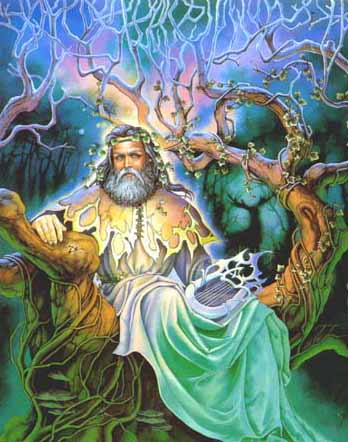
Merlin & The Tree of Life
Merlin
the Magician
Born
circa 400 CE ; Welsh: Myrddin;
Latin:
Merlinus; English: Merlin.
The restored and
landscaped Chester Amphitheatre
Some historians
believe that this was the site
of King Arthur’s
Round Table. Chester’s Roman fortifications
and its proximity to
the Welsh border have always made it a
strong candidate for the location of Camelot.
Chester is also often credited with
being the site of
“ The Battle of the
City of the Legion”
which was King Arthur’s ninth victory
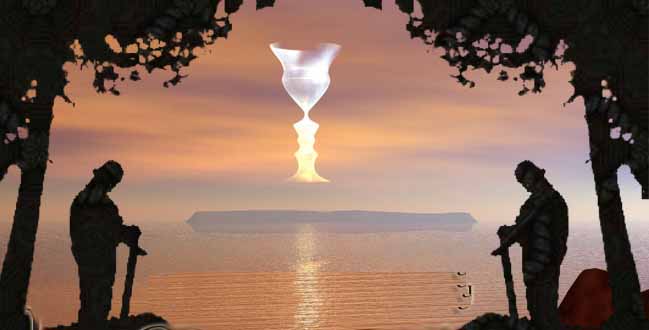
The Holy Grail
The Theosophy
King Arthur Pages
____________________
General pages
about Wales, Welsh History
and The History
of Theosophy in Wales
Theosophy
links
The Most Basic Theosophy
Website in the Universe
A quick overview of Theosophy
and the Theosophical Society
If you run a Theosophy Group you
can use this as an introductory handout.
Independent Theosophical Blog
One liners and quick explanations
About aspects of Theosophy
H P Blavatsky is usually the only
Theosophist that most people have ever
heard of. Let’s put that right
The Voice of the Silence Website
An Independent Theosophical Republic
Links to Free Online Theosophy
Study Resources; Courses, Writings,
The
By
William Quan Judge
GENERAL PRINCIPLES THE EARTH CHAIN
BODY AND ASTRAL BODY KAMA – DESIRE
KARMA KAMA LOKA
DEVACHAN
CYCLES
Classic Introductory Theosophy Text
A Text Book of Theosophy
By C
What Theosophy Is From the Absolute to Man
The Formation of a Solar System The Evolution of Life
The Constitution of Man After Death
Reincarnation
The Purpose of Life The Planetary Chains
The Result of Theosophical Study
Reincarnation
This
guide has been included in response
to the
number of enquiries we receive on this
subject
at Cardiff
Theosophical Society
From A Textbook
of Theosophy By C W Leadbeater
How We Remember our Past Lives
Life after Death & Reincarnation
The
Slaughter of the
a
great demand by the public for lectures on Reincarnation
An Outline of Theosophy
Charles Webster Leadbeater
Theosophy - What it is How is it Known?
The Method of Observation General Principles
Advantage Gained from this
Knowledge
The Deity The Divine Scheme The Constitution of Man
The True Man Reincarnation The Wider Outlook
Death Man’s Past and Future Cause and Effect
No
Aardvarks were harmed in the
The Occult World
By
Alfred Percy
Sinnett
The Occult
World is an treatise on the
Occult and
Occult Phenomena, presented
in readable style, by an early giant of
the
Theosophical Movement.
Preface to the American Edition Introduction
Occultism and its Adepts The Theosophical Society
First Occult Experiences Teachings of Occult Philosophy
Later Occult Phenomena Appendix
Theosophy Birmingham (England)
The Birmingham Annie Besant Lodge
The Seven
Principles of Man
By
Annie Besant
The Voice of the Silence Website
The Spiritual Home of Urban Theosophy
The Earth Base for Evolutionary Theosophy
Theosophical Glossary
Published 1892
A B C D EFG H IJ KL M N OP QR S T UV WXYZ
Try these if you are looking for a
local Theosophy
Group or Centre
UK Listing of Theosophical Groups
Theosophy House
Arthurian Picture Gallery
Arthur Marries Guinevere
Death of Arthur
Arthur draws the Sword from the Stone
Arthur draws the Sword for the Stone
Guinevere
The Lady of the
Guinevere lends her ring to Sir Lancelot
The Round Table
Theosophy House
Sir Bedivere returns Excalibur to the Lake
Sir Ghalahad brought before the Round Table
Lancelot and Guinevere
Sir Mordred
King Arthur
King Arthur
Death of Arthur
Morgan Le Fay
Theosophy House
Merlin instructs the young Arthur
Merlin instructs the young Arthur
Theosophy House
